HONDA ODYSSEY 1996 Owners Manual
Manufacturer: HONDA, Model Year: 1996, Model line: ODYSSEY, Model: HONDA ODYSSEY 1996Pages: 240, PDF Size: 2.64 MB
Page 201 of 240

If Your Engine Overheats
4. If the temperature gauge stays at the red mark, turn off the engine.
5. Wait until you see no more signs of steam or spray, then open the
hood.
6. Look for any obvious coolant leaks, such as a split radiator hose.
Everything is still extremely hot, so use caution. If you find a leak, it
must be repaired before you continue driving (see Towing on
page 213 ).
7. If you don't find an obvious leak, check the coolant level in the
radiator reserve tank (see page150 ). If the level is below the
MIN mark, add coolant to half-way
between the MIN and MAX marks.
8. If there was no coolant in the reserve tank, you may also have toadd coolant to the radiator. Let the
engine cool down until the pointer reaches the middle of the tempera-
ture gauge, or lower, before check-
ing the radiator.
9. Using gloves or a large heavy cloth, turn the radiator capcounterclockwise, without pushing
down, to the first stop. This
releases any remaining pressure in
the cooling system. After the pressure releases, push down on
the cap and turn it until it comesoff. 10.Start the engine and set the
temperature control lever tomaximum. Add coolant to the
radiator up to the base of the filler
neck. If you do not have the
proper coolant mixture available,
you can add plain water. Remember to have the coolingsystem drained and refilled with
the proper mixture as soon as you
can.
11. Put the radiator cap back on tightly. Run the engine and watch
the temperature gauge. If it goesback to the red mark, the engine
needs repair. (See Towing on
page 213.)
12.If the temperature stays normal, check the coolant level in the
radiator reserve tank. If it has gone down, add coolant to theMAX mark. Put the cap back on
tightly.
Taking Care of the Unexpected
Removing the radiator cap
while the engine is hot can
cause the coolant to spray out, seriously scalding you.
Always let the engine and radiator cool down before
removing the radiator cap.ProCarManuals.comMain Menu s t Table of Contents
Page 202 of 240
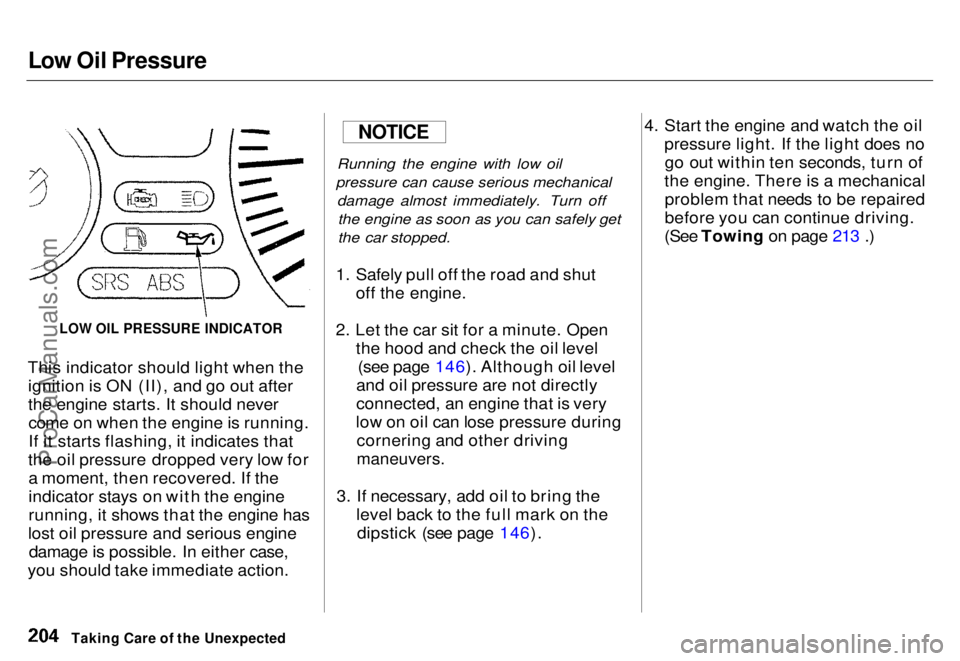
Low Oil Pressure
This indicator should light when the ignition is ON (II), and go out after
the engine starts. It should nevercome on when the engine is running.
If it starts flashing, it indicates that
the oil pressure dropped very low for a moment, then recovered. If the
indicator stays on with the engine
running, it shows that the engine has
lost oil pressure and serious engine damage is possible. In either case,
you should take immediate action.
Running the engine with low oil
pressure can cause serious mechanical damage almost immediately. Turn offthe engine as soon as you can safely get
the car stopped.
1. Safely pull off the road and shut off the engine.
2. Let the car sit for a minute. Open the hood and check the oil level(see page 146). Although oil level
and oil pressure are not directly
connected, an engine that is very
low on oil can lose pressure during cornering and other driving
maneuvers.
3. If necessary, add oil to bring the level back to the full mark on thedipstick (see page 146). 4. Start the engine and watch the oil
pressure light. If the light does nogo out within ten seconds, turn of
the engine. There is a mechanical problem that needs to be repaired
before you can continue driving.
(See Towing on page 213 .)
Taking Care of the Unexpected
NOTICE
LOW OIL PRESSURE INDICATORProCarManuals.comMain Menu s t Table of Contents
Page 203 of 240
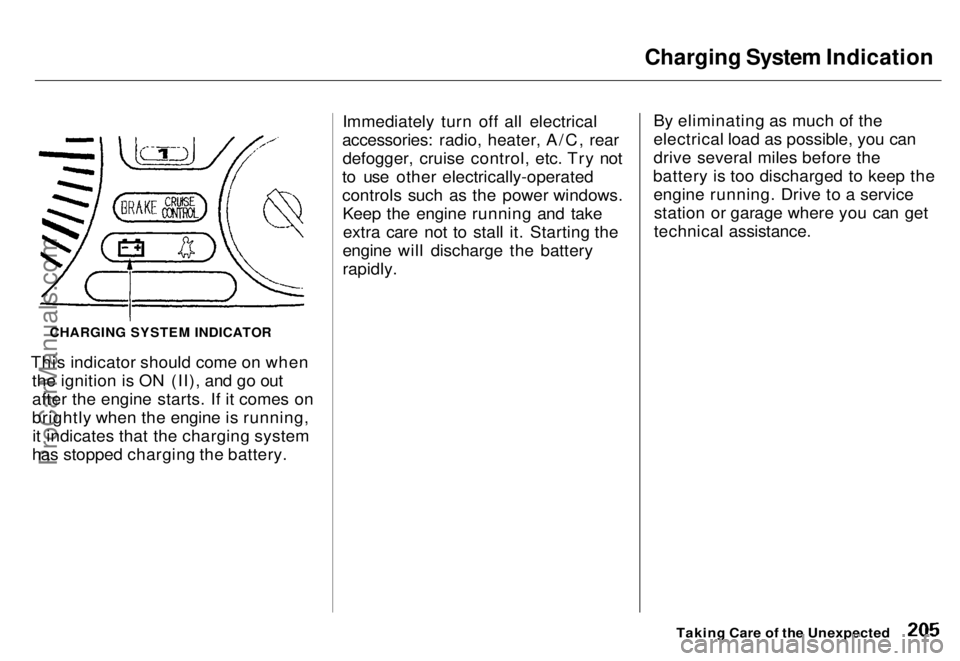
Charging System Indication
This indicator should come on when the ignition is ON (II), and go out
after the engine starts. If it comes on
brightly when the engine is running,it indicates that the charging system
has stopped charging the battery. Immediately turn off all electrical
accessories: radio, heater, A/C, rear defogger, cruise control, etc. Try not
to use other electrically-operated
controls such as the power windows. Keep the engine running and takeextra care not to stall it. Starting the
engine will discharge the battery
rapidly. By eliminating as much of the
electrical load as possible, you can
drive several miles before the
battery is too discharged to keep the engine running. Drive to a servicestation or garage where you can get
technical assistance.
Taking Care of the Unexpected
CHARGING SYSTEM INDICATORProCarManuals.comMain Menu s t Table of Contents
Page 204 of 240
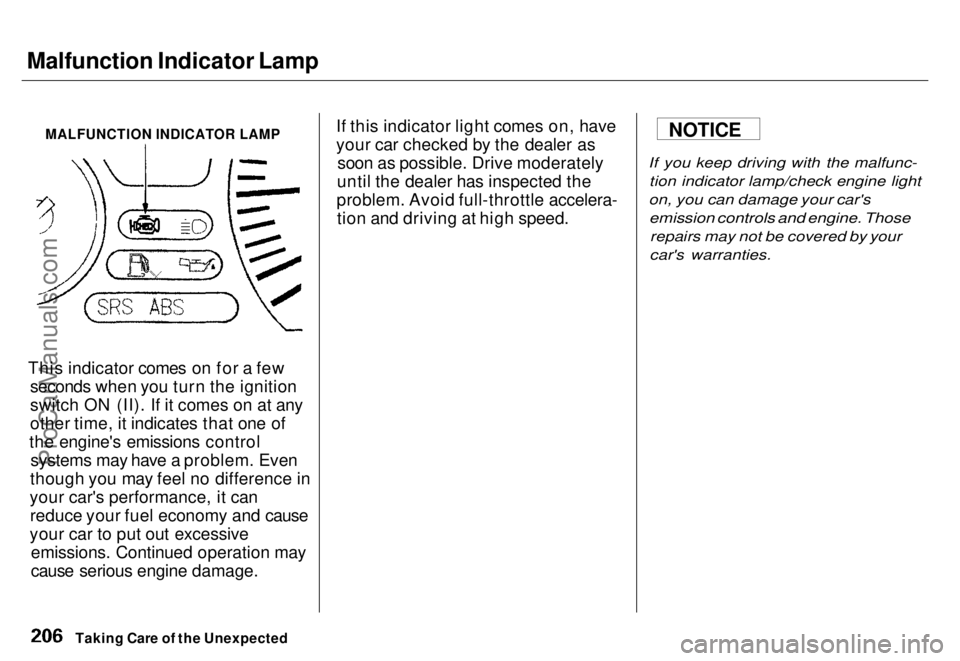
Malfunction Indicator Lamp
MALFUNCTION INDICATOR LAMP
This indicator comes on for a few seconds when you turn the ignition
switch ON (II). If it comes on at any
other time, it indicates that one of
the engine's emissions control systems may have a problem. Even
though you may feel no difference in
your car's performance, it can reduce your fuel economy and cause
your car to put out excessive emissions. Continued operation may
cause serious engine damage. If this indicator light comes on, have
your car checked by the dealer as
soon as possible. Drive moderately
until the dealer has inspected the
problem. Avoid full-throttle accelera- tion and driving at high speed.
If you keep driving with the malfunc-
tion indicator lamp/check engine light
on, you can damage your car's
emission controls and engine. Those
repairs may not be covered by your
car's warranties.
Taking Care of the Unexpected NOTICEProCarManuals.comMain Menu s t Table of Contents
Page 205 of 240
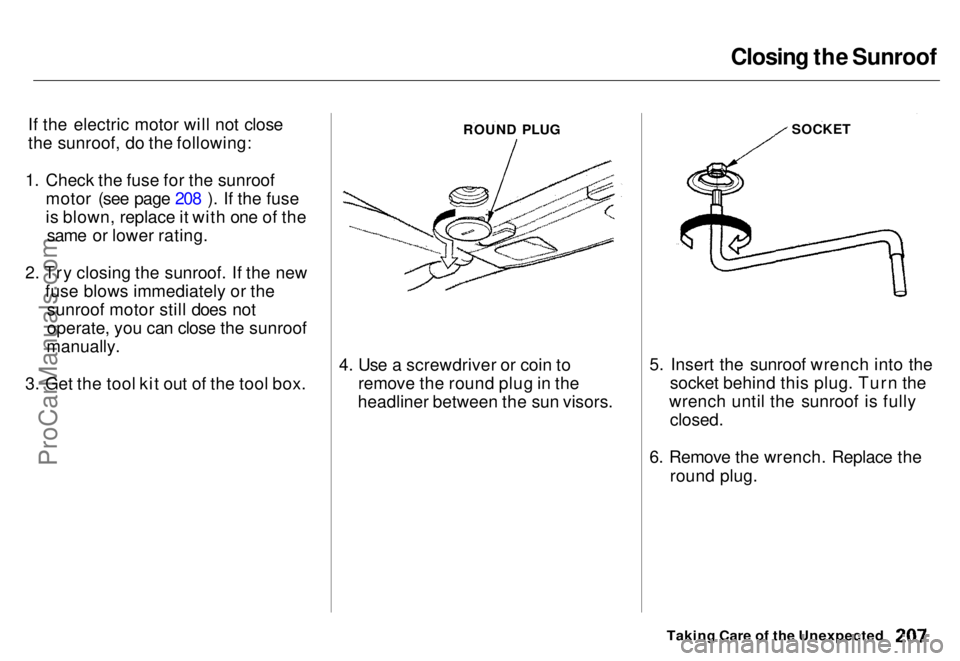
Closing the Sunroof
If the electric motor will not close
the sunroof, do the following:
1. Check the fuse for the sunroof motor (see page 208 ). If the fuse
is blown, replace it with one of thesame or lower rating.
2. Try closing the sunroof. If the new fuse blows immediately or thesunroof motor still does not
operate, you can close the sunroof
manually.
3. Get the tool kit out of the tool box. 4. Use a screwdriver or coin to
remove the round plug in the
headliner between the sun visors. 5. Insert the sunroof wrench into the
socket behind this plug. Turn the
wrench until the sunroof is fully
closed.
6. Remove the wrench. Replace the round plug.
Taking Care of the Unexpected
ROUND PLUG
SOCKETProCarManuals.comMain Menu s t Table of Contents
Page 206 of 240
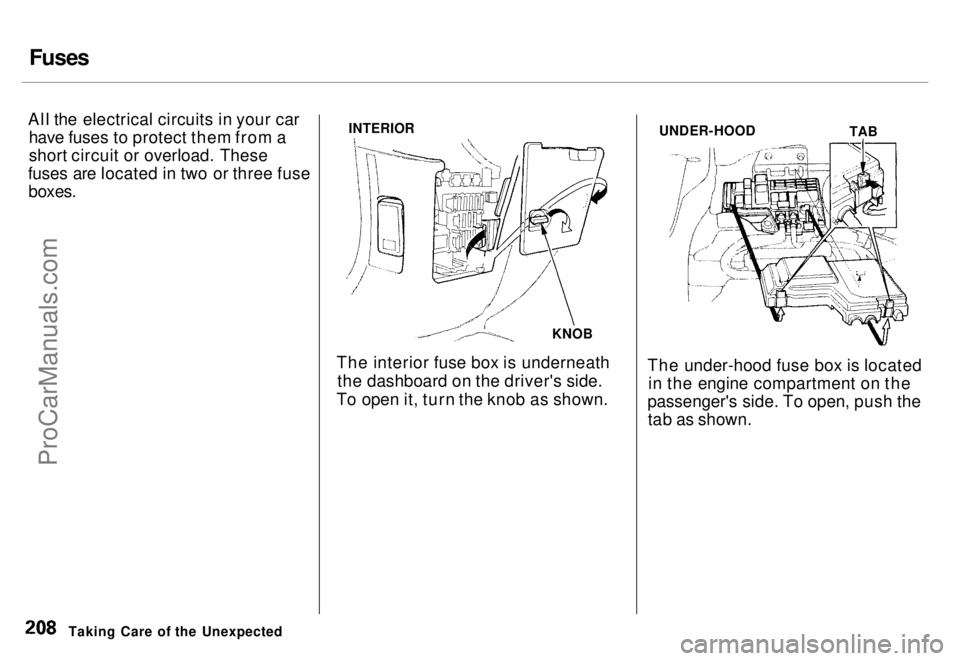
Fuses
All the electrical circuits in your car have fuses to protect them from a
short circuit or overload. These
fuses are located in two or three fuse
boxes.
INTERIOR
KNOB
The interior fuse box is underneath the dashboard on the driver's side.
To open it, turn the knob as shown. UNDER-HOOD
TAB
The under-hood fuse box is located in the engine compartment on the
passenger's side. To open, push the tab as shown.
Taking Care of the UnexpectedProCarManuals.comMain Menu s t Table of Contents
Page 207 of 240
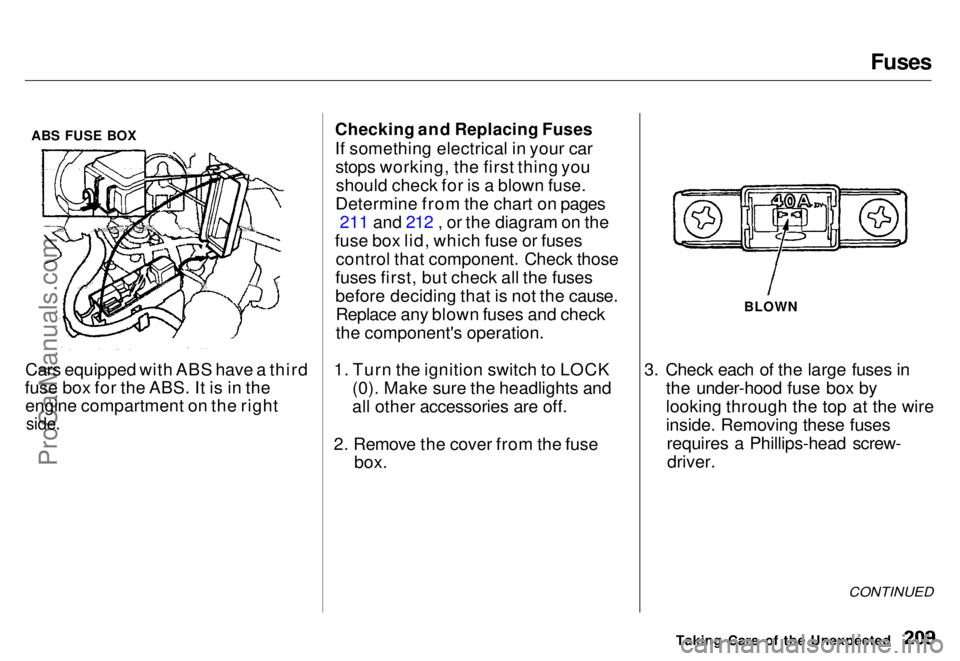
Fuses
ABS FUSE BOX
Cars equipped with ABS have a third
fuse box for the ABS. It is in the engine compartment on the right
side.
Checking and Replacing Fuses
If something electrical in your car
stops working, the first thing youshould check for is a blown fuse.
Determine from the chart on pages 211 and 212 , or the diagram on the
fuse box lid, which fuse or fuses control that component. Check those
fuses first, but check all the fuses
before deciding that is not the cause. Replace any blown fuses and check
the component's operation.
1. Turn the ignition switch to LOCK (0). Make sure the headlights and
all other accessories are off.
2. Remove the cover from the fuse box. 3. Check each of the large fuses in
the under-hood fuse box by
looking through the top at the wire
inside. Removing these fusesrequires a Phillips-head screw-driver.
CONTINUED
Taking Care of the Unexpected BLOWNProCarManuals.comMain Menu s t Table of Contents
Page 208 of 240
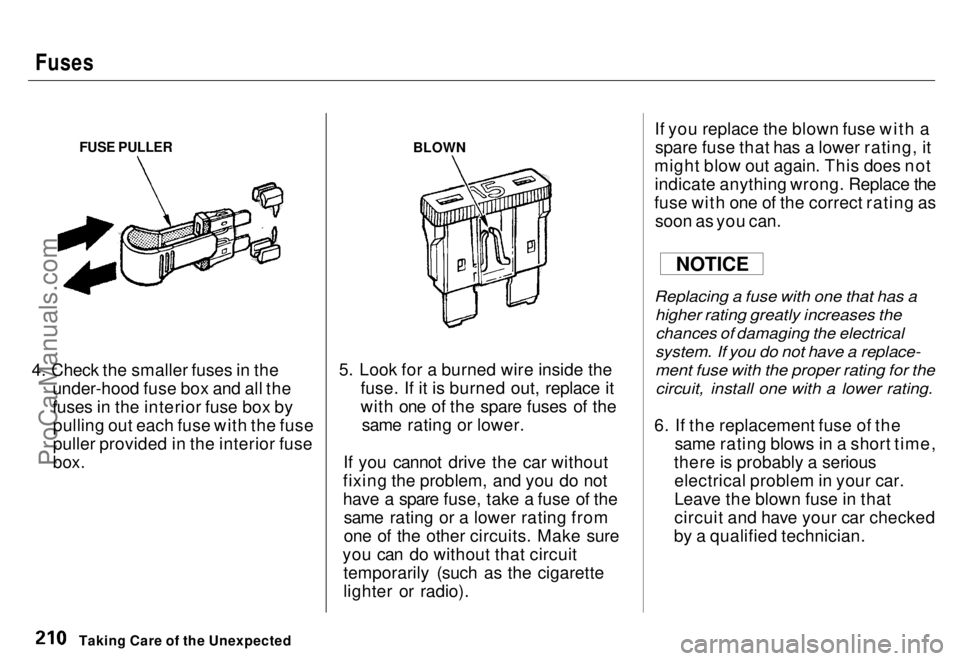
Fuses
4. Check the smaller fuses in the under-hood fuse box and all the
fuses in the interior fuse box bypulling out each fuse with the fuse
puller provided in the interior fuse
box.
5. Look for a burned wire inside the
fuse. If it is burned out, replace it
with one of the spare fuses of thesame rating or lower.
If you cannot drive the car without
fixing the problem, and you do not
have a spare fuse, take a fuse of the same rating or a lower rating from
one of the other circuits. Make sure
you can do without that circuit temporarily (such as the cigarette
lighter or radio). If you replace the blown fuse with a
spare fuse that has a lower rating, it
might blow out again. This does not indicate anything wrong. Replace the
fuse with one of the correct rating as soon as you can.
Replacing a fuse with one that has a higher rating greatly increases the
chances of damaging the electrical
system. If you do not have a replace-
ment fuse with the proper rating for the
circuit, install one with a lower rating.
6. If the replacement fuse of the same rating blows in a short time,
there is probably a serious electrical problem in your car.
Leave the blown fuse in that
circuit and have your car checked
by a qualified technician.
Taking Care of the Unexpected FUSE PULLER
BLOWN
NOTICEProCarManuals.comMain Menu s t Table of Contents
Page 209 of 240
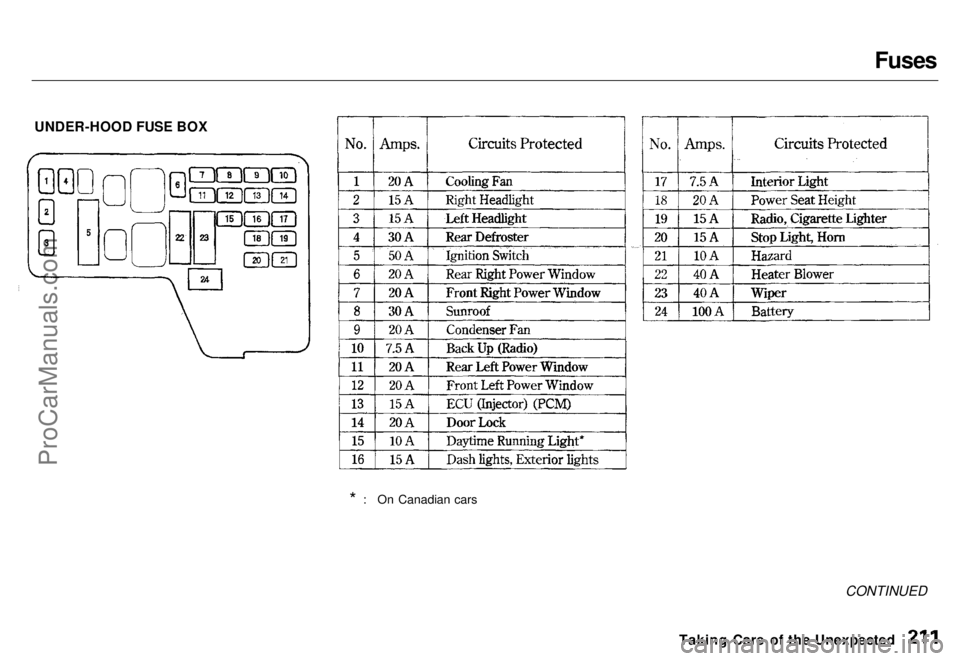
Fuses
UNDER-HOOD FUSE BOX
* : On Canadian cars
CONTINUED
Taking Care of the UnexpectedProCarManuals.comMain Menu s t Table of Contents
Page 210 of 240
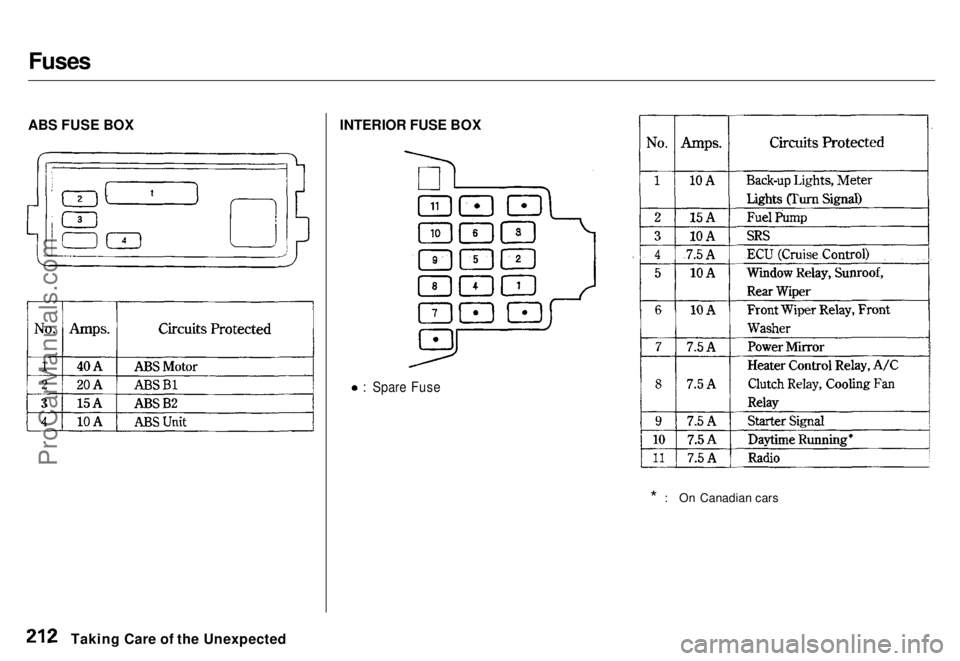
Fuses
ABS FUSE BOX INTERIOR FUSE BOX
: Spare Fuse
* : On Canadian cars
Taking Care of the UnexpectedProCarManuals.coms t Main Menu Table of Contents